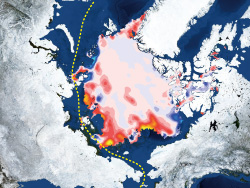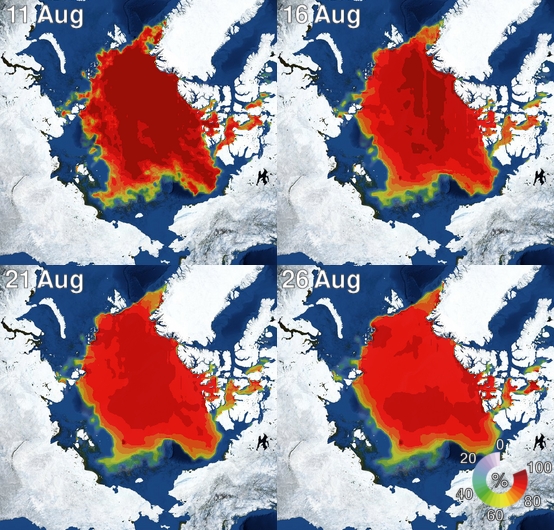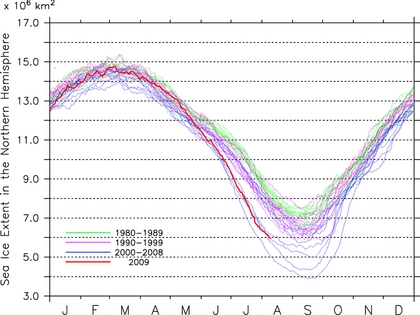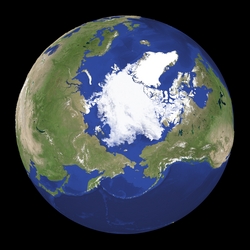2009.08.11
GIC Weekly Report for the Arctic Region Vol.2
Melting continues in Eastern passage
Topic of the Week

 Decreasing Decreasing Increasing Increasing |
Figure 1. Change in ice concentration between August 2nd and August 9th (click to enlarge)
Figure 1, indicates that sea ice is continuing to decrease throughout the North Eastern passage (denoted by yellow dotted line) suggesting a possible opening of this passage. However at present, this passage remains closed due to sea ice near Taimyr Peninsula, although sea ice extent and concentrations are decreasing within this region. One reason for the rapid reduction in sea ice, is the reduced presence of multi-year ice as a result of the Beaufort Gyre (cyclonic gyre on Beaufort Sea) and Transpolar Drift which moves sea ice from this region and accumulates it around Greenland and the Siberian Sea, as a result only new or grey ice can be found around the North Eastern passage, which is known to be particularly susceptible to melting at this time of year.
Other evidence for the suggested opening of the North Eastern passage is the fact that temperatures in the spring season were higher than last year throughout this region.
Within the North Western passage, there appears to be no drastic change in sea ice extent. However, within the past one to two weeks, fast ice within the Canadian Arctic region has melted. Analysis has shown that from the end of July to the first of August, is the peak season for fast ice to melt. This is particularly evident in the Canadian Arctic West, in which fast ice is reported to have dropped in concentration from about 90% to 40% within the last two weeks. This reduction in fast ice is a positive sign, as generally floating ice has a higher chance of melting when compared with fast-ice, as floating ice is affected by winds and currents,
Temperatures within the North Western passage are expect to be higher than average for this time of year, as a result of these facts it is expected that the North Western passage should open this year.
Sea Ice Extent
For this time of year, the sea ice extent for the Northern Hemisphere is recorded to be the third/fourth lowest ever recorded within historical records. The North Western/Eastern passages are also recorded to be the third/fourth lowest sea ice extent in recorded history. Figure 3. shows the extent of ice over the Arctic region, it can be clearly seen that the significant reduction in ice could possibility result in an opening of the Eastern passage in the next few weeks.
Sea Ice Conditions along Polar Routes
| NW Passage |
| Gulf of St.Lawrence |
Grand Banks |
Labrador Sea |
Davis Strait |
Baffin Bay |
Canadian Arctic E |
Canadian Arctic W |
Beaufort region |
Chukchi | Bering West |
| IF | IF | IF | IF | IF | IF | IF | IF | IF | |
| Greenland Sea SW |
Foxe Basin |
||||||||
| IF |
| NE Passage |
| Bering West |
Chukchi | East Siberian |
Laptev | Kara Sea N |
Barents Sea NE |
Barents Sea S |
Barents Sea NW |
| IF | IF | IF | IF | IF | |||
| Kara Sea S |
|||||||
| IF |
| Ice Concentration | Passage situation | |
| equal or more than 7 |
ships can not sail without icebreaker | |
| 4-6 | ice-strengthend ships can sail | |
| less than 3 | ice-worthy ships can sail | |
| IF | Ice Free | normal ships can sail |
Table. Sea ice extent for each region in the Arctic, showing the labelled colors to indicate navigable routes around the North Eastern and North Western passages.
Both Eastern and Western passages remain closed for the time being, although satellite imagery has revealed that there is an increased chance of both passages opening as a result of significant melting of sea ice. The resultant melting is a product of higher average temperatures throughout the region. This is particularly evident in the North Western passage within the Canadian Arctic West Sea, where higher temperatures has resulted in the melting of a significant amount of fast ice throughout the broad route leaving a resultant ice over of 9-10 tenths in concentration. The North Eastern passage suggests a similar pattern, with significant melting being seen within the Kara Sea North/South, Laptev Sea and the East Siberian Sea, The Kara Sea South's sea ice has almost complete receded leaving a clear route through this area, however there is still significant ice coverage within the Kara Sea North and Laptev Sea, Although there is a clear possibility of these areas clearing if this trend continues.
Model Prediction
Weathernews's I-SEE engine indicates that the rapid reduction in sea ice extent is set to continue, particularly throughout the Eastern passage. The Laptev Sea and East Siberian Sea will experience the greatest change with many areas reducing from 90-100% sea ice concentration to just 20-30%. The Global Forecasting model suggest that this sudden decrease is due to the seasonal increase in temperature, which in August will range from 10-250C over much of Eastern Russia, resulting in the melting of much of the first year and fast ice.
The North Western passage is forecast to show no significant change over August, with temperatures staying around 00C in much of the region. Throughout the Canadian Arctic East and West there can be seen a slight reduction in the concentration of sea ice however the presence of ice in this region will continue to stop the Western passage from opening throughout August.

Figure 4. I-SEE engine, model predictions of the arctic sea ice



